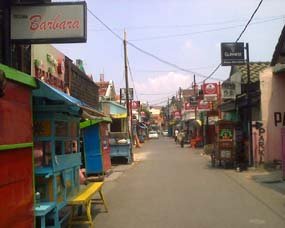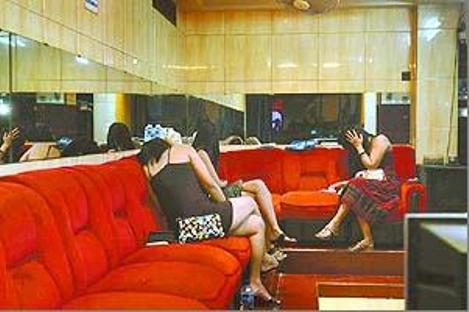By: Jacobus E. Lato
The nightfall shields the day and transforms it in different ways, particularly in Dolly, Surabaya. In an approximately 5 meter wide 150 meter long alley, the night brings an extremely different atmosphere. Walking passed the alley that morning, I hardly noticed that beautiful girls flocked the area. Some sleepy girls were hanging around some food vendors and warung (eateries).
There was no sign of any hospitality; no greetings and bright smiles followed by whispers ones ear and tender caresses. No soaring music, bright lights, quasi-dancing, sensual wriggling. Various parking lots contained only some motorcycles and mobiles. Some passersby peeping into a house seemed disappointed and rushed to the end of the alley. The call of the prayer amplified by speakers of the nearby mosques. It’s ten minutes to six and dusk, time to go to the mosque. A couple of hours ago no one in Dolly had that holy place in mind.
Dolly by Night
“In the morning, most prostitutes spend their time sleeping. They have been working till midnight the night before,” Yudhis of Yayasan Abdi Asih, Surabaya told me then continued; “It is their special time with their kiwir-kiwir or gendakan. At three they assume their activities; take a bath, get dressed and get themselves ready for their customers by sitting in their booth.”
Kiwir-kiwir is the local slang for prostitutes’ boyfriends; usually called brondong, young boys. Gendakan denotes the older or illegal spouses. In a special relationship these men spend time with the prostitutes when they’re not working; some of the prostitutes even look after them.
Dolly from five to the middle of the night is another world. Its real character surfaces, only to resume an air of normal life during the day. Night time changes the atmospheres as well as the people. Girls seem to change in appearance in minutes. Clad in their dresses, legs and shoulders bare, eyelashes curled, lips painted, they sit on exclusive couches of a pane booth. Male costumers watch, spy and select the girl to their liking from the outside. Sometimes busy managing recruiters boost the services the girls offer.
Sex and Lust Trade on Tombs
Surabaya has more prostitution areas besides Dolly; Kremil, Kembang Kuning, Dupak Bangunsari, Jarak and Moroseneng and some street prostitute hangouts. About 2,321 prostitutes work in Surabaya under the power of their 534 pimps. As the most visible and the most prestigious localization, Dolly is flanked by two other locations of a different class, ‘service’ and price.
Jarak at the end of the T-section, houses second class prostitutes. While Kembang Kuning about 1 kilometer away revolves more around street sex. It was a former Dutch Cemetery and now publicly used as Christian Cemetery. Some female sex workers work there along with more than 150 waria, transgenders, hang around awaiting their prey in the dimmed street light. Sex and lust trade on tombs throughout the compound.
Islamic Boarding Schools vs. Brothels
East Java Province Governor, Sukarwo expressed his deepest concern on this matter to the members of Indonesian Ulema Council (MUI) members in November 2011. According to Sukarwo there are 7,127 prostitutes now earning a living from selling sex; working at 47 locations under 1,037 pimps across the province. What strikes him most is the fact that East Java at the same time is the base of pondok pesantren, Islamic boarding schools: “Of course, it is an ironic condition with regards to East Java as a base of pondok pesantren. According to my personal record, there are 6,003 pondok pesantren with 888,211 santri (students) in this province.” Soekarwo then continued detailing that 96.78 percent of the population is Muslim and it stimulates him in his plan to shut down prostitution in the region by 2014.
Pondok pesantren is an Islamic traditional boarding school system usually linked to Nahdlatur Ulama (NU) the biggest Muslim organization in Indonesia. Santri, their students are entitled to learn more Islamic teachings after schooling, compared to common students, besides the official curriculum that now has about 13 subjects to offer. There are still more islamic boarding schools than brothels in East Java, but for a country where prostitution is illegal and the great majority is Muslim, red light districts raise red flags.
Nothing Left to Sell
Indonesians are varied in their response to prostitution. A common response is to attempt banning it and closing brothels effectively during the Islamic fasting month, Ramadhan. Another sanction sees the taxing of prostitutes’ fees; creating only more controversy, since the revenues are considered haraam or forbidden according to Islamic teachings.
Amid all this controversy, the East Java Province branch of the Indonesian Ulema Council (MUI) welcomes Sukarwo’s idea. The association is setting up a program, Association of Preachers for Red-Light Districts (Idial), a local movement involving ulema and other elements of the community. The program encourages prostitutes and other inhabitants of the red-light districts to get out of the commercial-sex business: “We give them religious instruction while the administration provides them with skills and funding for a new life,” the chairman of the association, Abdussomad Buchori said.
He added that the program had been successful in its pilot project in Dupak Bangunsari red-light district in Surabaya. The localization gradually returns prostitutes to their villages; the area previously accommodated some 2,700 prostitutes but now only had 127 left, most of whom were older women.
Ulema is of course on the side of religion; doing their prophetic duty, especially when the number of HIV/AIDS infections in the country is alarming and economic life is at stake. ILO data shows that the number of HIV/AIDS-infected people in Indonesia will increase to 501,400 in 2014 up from 227,700 in 2008. The government should manage the situation since human desire survives in nature. And people are often forced, selling their body as their last resource, as an old prostitute in Jarak told me last week: “I have nothing to sell for living except this one,” pointing at her private parts.













